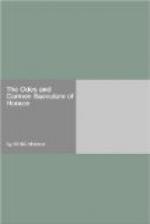For the place of the Alcaic there are various candidates. Mr. Tennyson has recently invented a measure which, if not intended to reproduce the Alcaic, was doubtless suggested by it, that which appears in his poem of “The Daisy,” and, in a slightly different form, in the “Lines to Mr. Maurice.” The two last lines of the latter form of the stanza are indeed evidently copied from the Alcaic, with the simple omission of the last syllable of the last line of the original. Still, as a whole, I doubt whether this form would be as suitable, at least for a dignified Ode, as the other, where the initial iambic in the last line, substituted for a trochec, makes the movement different. I was deterred, however, from attempting either, partly by a doubt whether either had been sufficiently naturalized in English to be safely practised by an unskilful hand, partly by the obvious difficulty of having to provide three rhymes per stanza, against which the occurrence of one line in each without a rhyme at all was but a poor set-off. A second metre which occurred to me is that of Andrew Marvel’s Horatian Ode, a variety of which is found twice in Mr. Keble’s Christian Year. Here two lines of eight syllables are followed by two of six, the difference between the types being that in Marvel’s Ode the rhymes are successive, in Mr. Keble’s alternate. The external correspondence between this and the Alcaic is considerable; but the brevity of the English measure struck me at once as a fatal obstacle, and I did not try to encounter it. A third possibility is the stanza of “In Memoriam,” which has been adopted by the clever author of “Poems and Translations, by C. S. C.,” in his version of “Justum et tenacem.” I think it very probable that this will be found eventually to be the best representation of the Alcaic in English, especially as it appears to afford facilities for that linking of stanza to stanza which one who wishes to adhere closely to the logical and rhythmical structure of the Latin soon learns to desire. But I have not adopted it; and I believe there is good reason for not doing so. With all its advantages, it has the patent disadvantage of having been brought into notice by a poet who is influencing the present generation as only a great living poet can. A great writer now, an inferior writer hereafter, may be able to handle it with some degree of independence; but the majority of those who use it at present are sure in adopting Mr. Tennyson’s metre to adopt his manner. It is no reproach to “C. S. C.” that his Ode reminds us of Mr. Tennyson; it is a praise to him that the recollection is a pleasant one. But Mr. Tennyson’s manner is not the manner of Horace, and it is the manner of a contemporary; the expression—a most powerful and beautiful expression—of influences to which a translator of an ancient classic feels himself to be too much subjected already. What is wanted is a metre which shall have other associations than those of the nineteenth century, which shall be the growth of various




